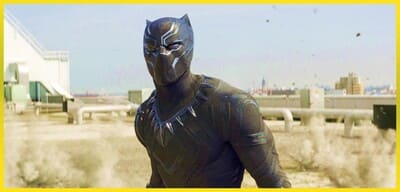Black Panther & the Art of Creating Incredible Visual Effects
Since the MCU juggernaut started rolling, there has been nothing but excitement about all the upcoming movies in the franchise. It was of course no surprise that Avengers Infinity War was one of the most well received films in recent times. However, it was quite a pleasant surprise that film Black Panther grossed close to half a billion dollars worldwide and became one of the most loved films in the Marvel Cinematic Universe.
The film was a definitely a commercial success and was also hailed critically. The coveted Oscar nominations along with the humongous worldwide collection is ample proof of that. There were of course multiple reasons for this. Apart from the obvious reasons like a stellar cast, impactful African-American representation and strong women characters, one of the most crucial elements responsible for this film’s success is the mind-boggling visual effects (VFX) perfectly, impeccably used in it.


The Production VFX Supervisor for Black Panther is Geoffrey Baumann and he is probably still basking in the glory. Having previously worked for numerous amazing films like G.I Joe: The Rise of the Cobra, Speed Racer and Transformers, he definitely has outdone himself with this movie. The credits for the visual effects of the movie however are not Geoffrey Baumann’s alone. There was an entire arsenal of VFX studio and hundreds of artists who were involved in making this masterpiece come to life.
The visual effects for Black Panther were made by multiple studios and all of them played a key role in making this film the grand success that it is. Following is the list of the key contributors who made it possible:
- Industrial Light & Magic (VFX Supervisor: Craig Hammack)
- Digital Domain
- Double Negative (VFX Supervisor: Stuart Lashley)
- Luma Pictures (VFX Supervisors: Vincent Cirelli & Brendan Seals)
- Mammal Studios
- Method Studios (VFX Supervisor: Andy Brown)
- Rise Visual Effects Studios
- Scanline VFX
- Storm Studios
- Trixter
- Perception NYC…
…and a whole lot of individual talent.
To make a premium, path breaking VFX-backed film was a tough nut to crack with exemplary work happening all around us. There were many challenges and obstacles faced by the team. To strike the perfect balance between realism and digital augmentation, creatively and technically was the main daunting and crucial aspect.
One of the many key challenges was to craft digital performances for actors specifically the Black Panther and Killmonger. The other was to digitally choreograph the battle sequences. Initially suits with digital pop-ups were used but they were breaking down, so more high-tech functionality and design were added to the suits after collaboration with Marvel Studios. Foam blocks and other props were used with actors initially to get two things sorted; the actors’ movements, mannerisms and the camera angles. A lot of the digital components like the background landscapes were added later using CG (Character Graphics). Roto-Animation was also used for a few scenes to add in factors like the CG mountains, landscapes, neck deformation and other physical nuances.
A lot of the scenes had to digitally recreated and computer generated because the central characters in the film were using helmets. There is a scene in the movie where the Killmonger’s clothing is burning off the body and what had to be done was digitally line up CG version of the Killmonger underneath the actor’s performance. Other few crucial elements that had to be considered were the suit designs for Black Panther and the Killmonger, the energy force, the feel of the vibranium technology and the nanite particles that unfurl across the actor’s body as they form the suit. Any concussive impact on the suit which actually absorbs the energy was also needed to be visually seamless. This involved photography of the actors and their stunt doubles to understand how their muscles and body would move. Digital doubles which are computer generated versions of the performers had to be made to seamlessly augment and that had to be captured digitally. They had to be multiplied to make the action sequences look more expansive and elaborate. The key element is to retain as much live action photography as you can to make the scenes look more realistic. A perfect blend was used as the combination of live action photography and digital augmentation which makes a hybrid technology that retains the authenticity of the performances and digitally amplifies the elements that add to the cinematic viewing experience. The animals/creatures work especially the rhinos, their locomotion, actions, etc. used in this film was also an important element that needed a lot of work. A lot of it has to be credited to creative interpretation as there is not much reference material for it.
There is a combination of the whole animation and VFX gamut when it comes to films like the Black Panther and that is why it is considered to be one of the pioneering modern-day VFX-enabled film in recent times. It includes all elements like roto-animation to digital intervention to CG to live action photography and the works. Thorough research along with heavy technical and technological aspects have to be holistically considered while making such a Magnum Opus.
Rated as one of the leading visual effects (VFX) colleges in India, Seamedu School of Pro-Expressionism believes that learning should be through hands-on training and live projects and not limited to the traditional classroom environment of theoretical teaching. Our infrastructure and state-of-the-art facilities allow our students to practically try their hands on the entire VFX gamut, start from the core basics and subsequently achieve a level of proficiency that empowers them to excel at the industry level.
Having contributed to building a strong talent pool of VFX artists in the Indian film, TV and web industry, Seamedu is proud to be associated with renowned VFX studios around the country. Enroll in our comprehensive degree in VFX that can equip you with the knowledge and practical proficiency to make highly realistic and awe-inspiring visual effects for games, movies and/or series.


CATEGORIES
Are you aspiring to become a proficient Animation & VFX professional?
Look no further; we are committed to nurturing the potential of young minds. Are you ready to enhance your skills?


